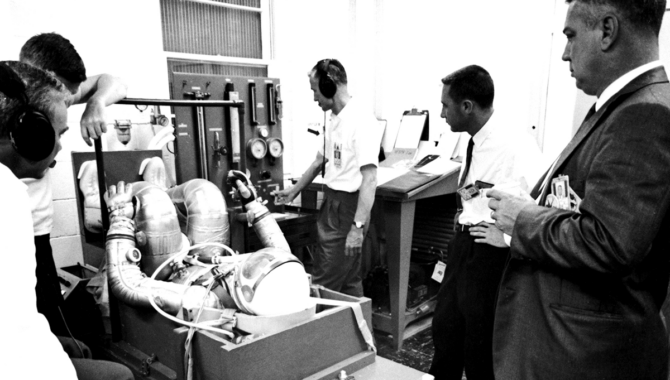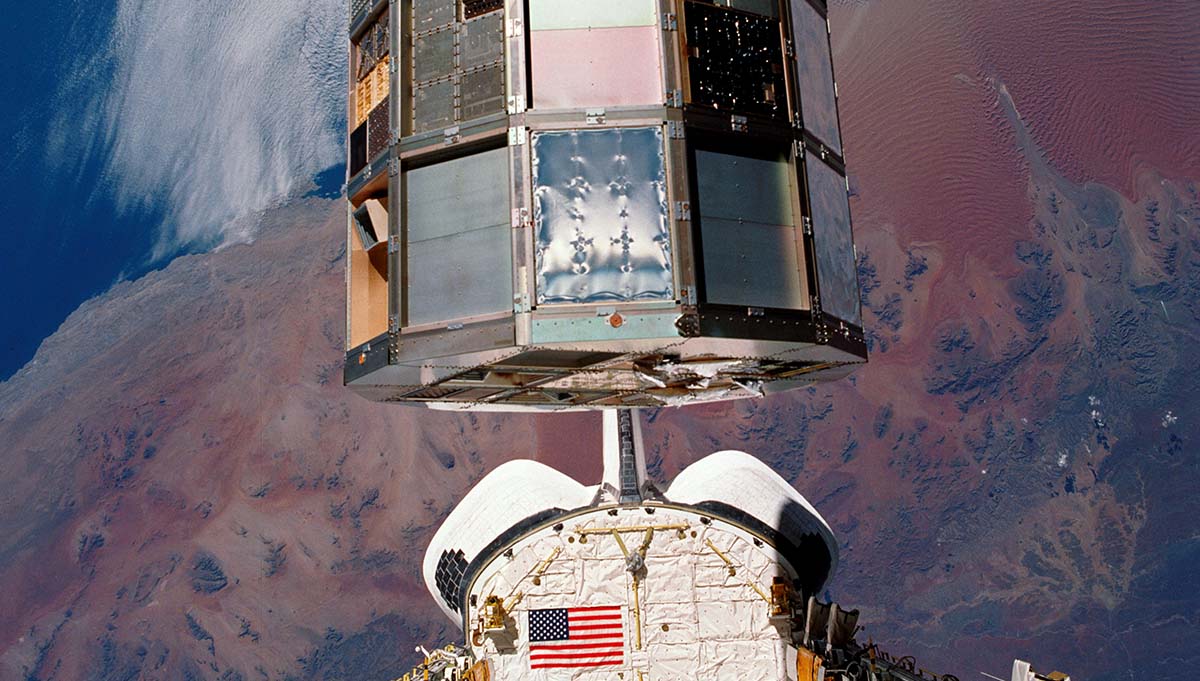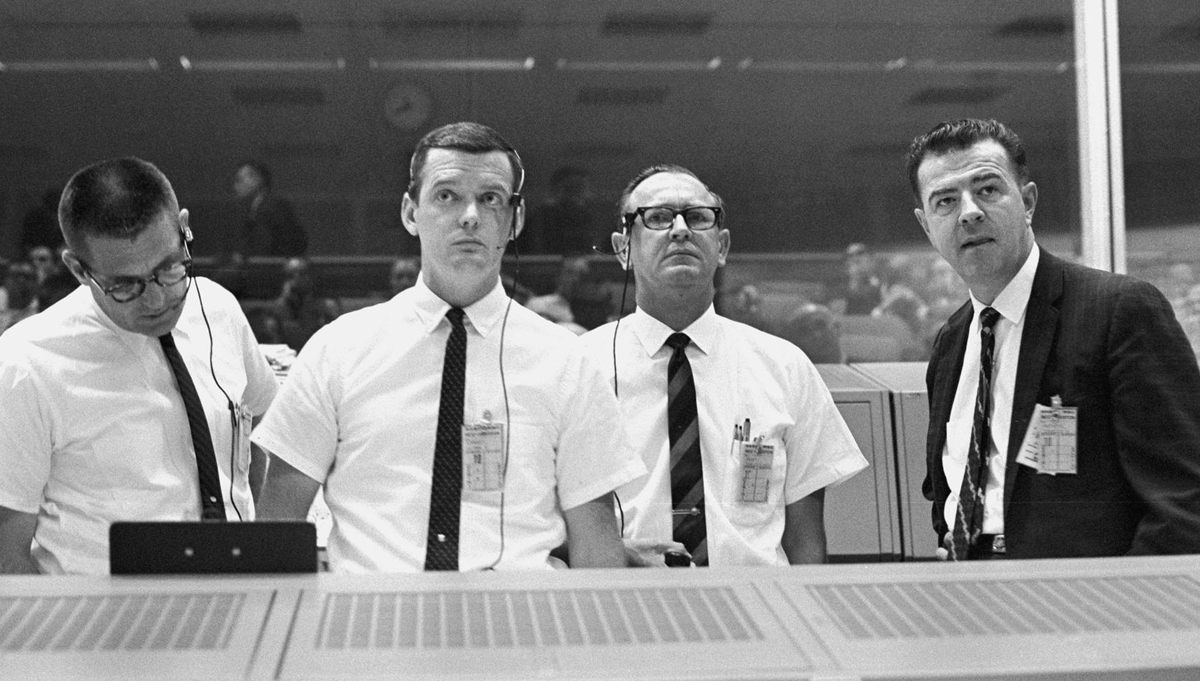
Astronaut Alan B. Shepard Jr. sits in a flight couch for final testing before Mercury-Redstone 3.
Credit: NASA
Astronaut tells rocket: ‘Okay buster, let’s go and get the job done.’
On April 9, 1959, NASA brought together the nation’s first astronauts for a press conference. Alan B. Shepard Jr., an accomplished test pilot in the U.S. Navy, sized up his fellow Mercury 7 astronauts, drawn from the top pilots in the U.S. military. He already knew John H. Glenn, Jr. and Walter M. Schirra, Jr. He had met M. Scott Carpenter, L. Gordon Cooper Jr., Virgil I. (Gus) Grissom, and Donald K. (Deke) Slayton during the preliminary selection process.
“I knew there was a lot of talent there, and I knew that it was going to be a tough fight to win the prize,” Shepard said, in an oral history.

Insignias from each of six manned Mercury 7 missions and autographs of the original seven NASA astronauts encircle the Mercury spacecraft.
Credit: NASA
The prize was to be the first human launched into space in a Project Mercury capsule, a cone-shaped spacecraft just 6 ft., 10 in. long and 6 ft. 2.5 in. in diameter, built largely from titanium, with nickel-steel alloy and beryllium shingles in key locations and capped on the blunt end with an ablative heat shield capable of withstanding 3,000-degree reentry temperatures. The first Mercury capsules launched atop the Redstone rocket, a converted ballistic missile with a maximum thrust of 78,000 pounds.
Nearly two years of training stood between the Mercury 7 and the prize. This training included time in a centrifuge to simulate the experience of the 11 g reentry forces. They took flights in a padded cargo plane to experience moments of weightlessness. They each spent five arduous hours in the Multiple Axis Space Test Inertia Facility, using a control stick like the one in the Mercury capsule to stabilize a simulated cockpit tumbling at incredible speeds in multiple directions at once.
“In the early days we really had what we called ‘part-task trainers’ instead of simulators. Something was built to indicate the control system; something else was built to indicate the radio systems or some of the instruments. And they were all sort of separated, not the great, glorious simulators which we have today,” Shepard recalled in 1998.
“You’re dealing with individuals who fly unusual aircraft, who conduct unusual experiments infrequently, because you don’t fly in space every day. So there has to be the simulator, which … artificially creates problems for you to train against or train with, to learn how to overcome difficulties…,” Shepard said.

Alan B. Shepard Jr. in his pressure suit, with helmet opened, before the Mercury-Redstone 3 flight that made him the first American in space.
Credit: NASA
Shortly before Mercury-Redstone 2, a test mission in January 1961 that put a chimpanzee into space, Robert R. Gilruth, the Director of NASA’s Space Task Group, called the astronauts together for a late afternoon meeting. Shepard recalled Gilruth walking into the room, closing the door, and saying that NASA had to decide who would be assigned the first Mercury-Redstone missions.
“ ‘Shepard gets the first flight, Grissom gets the second flight, and Glenn is the backup for both of these two sub-orbital missions. Any questions?’ Absolute silence. He said, ‘Thank you very much. Good luck,’ turned around, and left the room,” Shepard recalled.
“Well, there I am looking at six faces looking at me and feeling, of course, totally elated that I had won the competition. But yet, almost immediately afterwards feeling sorry for my buddies, because there they were. I mean, they were trying just as hard as I was and it was a very poignant moment because they all came over, shook my hand, and pretty soon I was the only guy left in the room,” Shepard said.
Early on May 5, 1961—62 years ago this month—Alan Shepard was driven to a launchpad at Cape Canaveral. Mercury-Redstone 3 towered 83 feet above him against the dark Florida sky. Liquid oxygen was venting out, glowing in the searchlights. “And I remember saying to myself, ‘Well, I’m not going to see this Redstone again.’ And you know, pilots love to go out and kick the tires. It was sort of like reaching out and kicking the tires on the Redstone because I stopped and looked at it, . . . looked back and up at this beautiful rocket, and thought, ‘Well, okay buster, let’s go and get the job done,’ ” Shepard said.

Launching of the Mercury-Redstone 3 (MR-3) spacecraft from Cape Canaveral on a suborbital mission.
Credit: NASA
The rocket launched at 9:34 a.m. NASA’s first crewed spaceflight was a success. The Redstone booster performed within design limits. Shepard was able to control the Mercury capsule manually. He experienced 6 g’s during the ride into space and nearly 12 g’s during reentry. The flight was brief—just 15 minutes and 22 seconds. He reached an altitude of 116.5 statute miles and experienced about 5 minutes of weightlessness. Recovery crews were close enough to watch the capsule’s descent and reached Shepard in two minutes. The spaceflight made Shepard the second human and the first American in space.
Two years later, following Mercury-Atlas 9, Shepard lobbied for one final Mercury mission, even as NASA’s attention had turned to Project Gemini. “My thought was to put me up there and just let me stay until something ran out; until the batteries ran down, until the oxygen ran out, or until we lost a control system or something. Just an open-ended kind of a mission. And so, I recommended that, and they said that they didn’t expect to hear anything else from me,” Shepard joked.
Initially assigned as Commander of Gemini 3, the first crewed mission of the program, Shepard was grounded because of dizziness and balance issues caused by an inner ear condition known as Ménière’s Disease. He was appointed as Chief of the Astronaut Office in November 1963, where he had a significant impact on astronaut training and crew selection. A successful surgery in 1968 eliminated his inner ear symptoms and he was returned to flight status on May 7, 1969. On February 5, 1971, Shepard became the only Mercury 7 astronaut to walk on the Moon.









